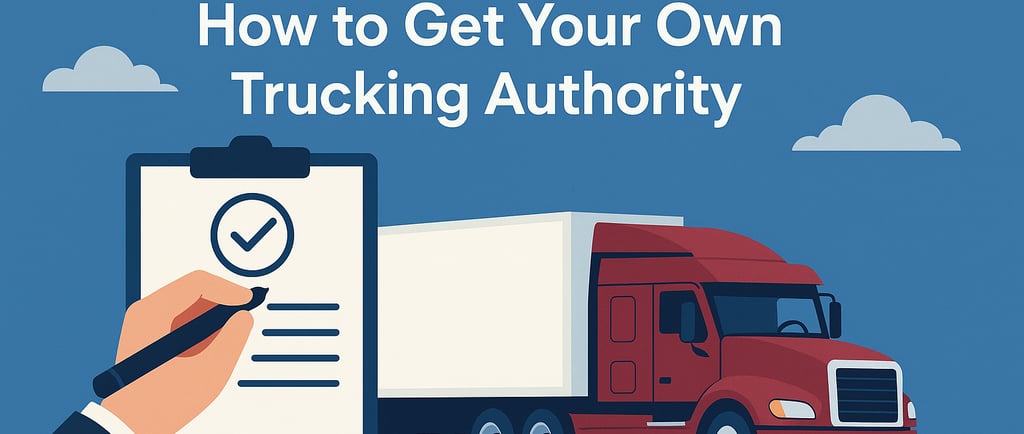Step-by-Step Guide: How to Get Your Own Trucking Authority
A comprehensive beginner’s guide that walks you through each step of obtaining trucking authority, from setting up your business to getting insured and staying compliant.
CDL2CEO
8/21/20252 min read


Learn how to get your own trucking authority in 10 steps. From LLC setup to FMCSA registration, insurance, BOC-3 filing, and compliance, this guide covers everything new trucking entrepreneurs need to start their business.
What Is Trucking Authority and Why Do You Need It?
Trucking authority — also known as operating authority — is permission from the FMCSA (Federal Motor Carrier Safety Administration) that allows a trucking company to operate as a for-hire carrier across state lines.
When you get your authority, you’ll receive:
A USDOT Number (tracks safety and compliance)
An MC Number (identifies your operating authority)
Having your own authority means:
✅ You control your freight contracts
✅ You can work directly with shippers and brokers
✅ You earn higher rates than leased drivers
Step 1: Choose Your Business Structure
Before applying, form a legal business entity. Most new carriers choose an LLC for liability protection and tax benefits.
LLC: Best balance of cost & protection.
Corporation: Good for expansion.
Sole Proprietorship: Simplest, but least protection.
Step 2: Apply for USDOT & MC Numbers
Register through the FMCSA Unified Registration System.
Fee: $300
You’ll get both a USDOT Number and an MC Number
Step 3: Secure Commercial Insurance
Your authority won’t go active without insurance. Minimums required:
Liability Insurance: $750,000 (most brokers require $1M)
Cargo Insurance: $100,000
Optional: Physical damage, bobtail, trailer interchange
Step 4: File a BOC-3 (Designation of Process Agent)
Hire a service ($20–50) to file your BOC-3. This designates agents in each state to receive legal documents on your behalf.
Step 5: Pay Your Unified Carrier Registration (UCR) Fee
Annual UCR fees are based on fleet size.
1–2 trucks = $47/year
Step 6: Register for IFTA & IRP (If Required)
If you haul interstate, you’ll need:
IFTA (fuel tax reporting across states)
IRP (apportioned plates for interstate trucking)
Step 7: Build Your Compliance Program
FMCSA requires carriers to maintain:
Driver qualification files
Drug & alcohol testing consortium enrollment
Hours-of-service tracking (ELDs)
Step 8: Get Load Board Access & Broker Approval
Use load boards (DAT, Truckstop) to find freight
Apply with brokers (W-9, COI, carrier packet required)
Step 9: Activate Your Authority
After 21 days, FMCSA activates your authority if everything is in place. You can now legally haul loads for hire.
Step 10: Grow Your Trucking Business
Build broker & shipper relationships
Use factoring for steady cash flow
Track compliance deadlines to stay active
FAQ: Getting Your Own Trucking Authority
Q: How much does it cost to get trucking authority?
Between $5,000–$12,000, depending on insurance rates and startup expenses.
Q: How long does it take to activate authority?
Typically 21 business days after your MC application.
Q: Do I need authority if I only run intrastate?
Not always — check with your state DOT.
Q: What’s the biggest expense?
Insurance is usually the largest upfront cost.
Final Thoughts
Getting your own trucking authority is the first step toward building a profitable, independent trucking business. By following these steps, you’ll move from driver-for-hire to CEO of your own company.
💡 Next Step: Want a ready-made Trucking Authority Toolkit (checklists, scripts, templates)? 👉 Click here to get started